Highly effective photocatalyst of TiO2 nanoparticles dispersed on carbon nanotubes for methylene blue degradation in aqueous solution
In the present study, titania nanoparticles are highly dispersed on carbon nanotubes via hydrolysis process of tetraisopropyl-orthotitanate Ti[OCH(CH3)2]4 (TPOT). The obtained composite (TiO2/CNTs) is characterized by modern
methods. The anatase-TiO2 phase is realized based on X-ray diffraction spectrum at different pHs of hydrolysis
solution. The band gap of TiO2/CNTs (Eg) is calculated by Tauc method using diffuse reflectance spectroscopy (DRS).
The TiO2/CNTs composite plays as an active photocatalyst for methylene blue (MB) decomposition in aqueous
solution. The effect of time to photocatalytic ability of TiO2/CNTs composite is described using LangmuirHinshelwood kinetic model. The values of enthalpy variation (H), entropy change (S) and Gibbs free energy
variation (G) of the decomposition of MB are determined from thermodynamic study. In the range temperature from
283 K to 323 K, the positive values of H and negative value of G confirms endothermic and spontaneous nature of
MB degradation. With the increase of temperature, the reaction occurs more easily, which is proved by more negative
values of Gibbs free energy calculated from Van’t Hoff equation.
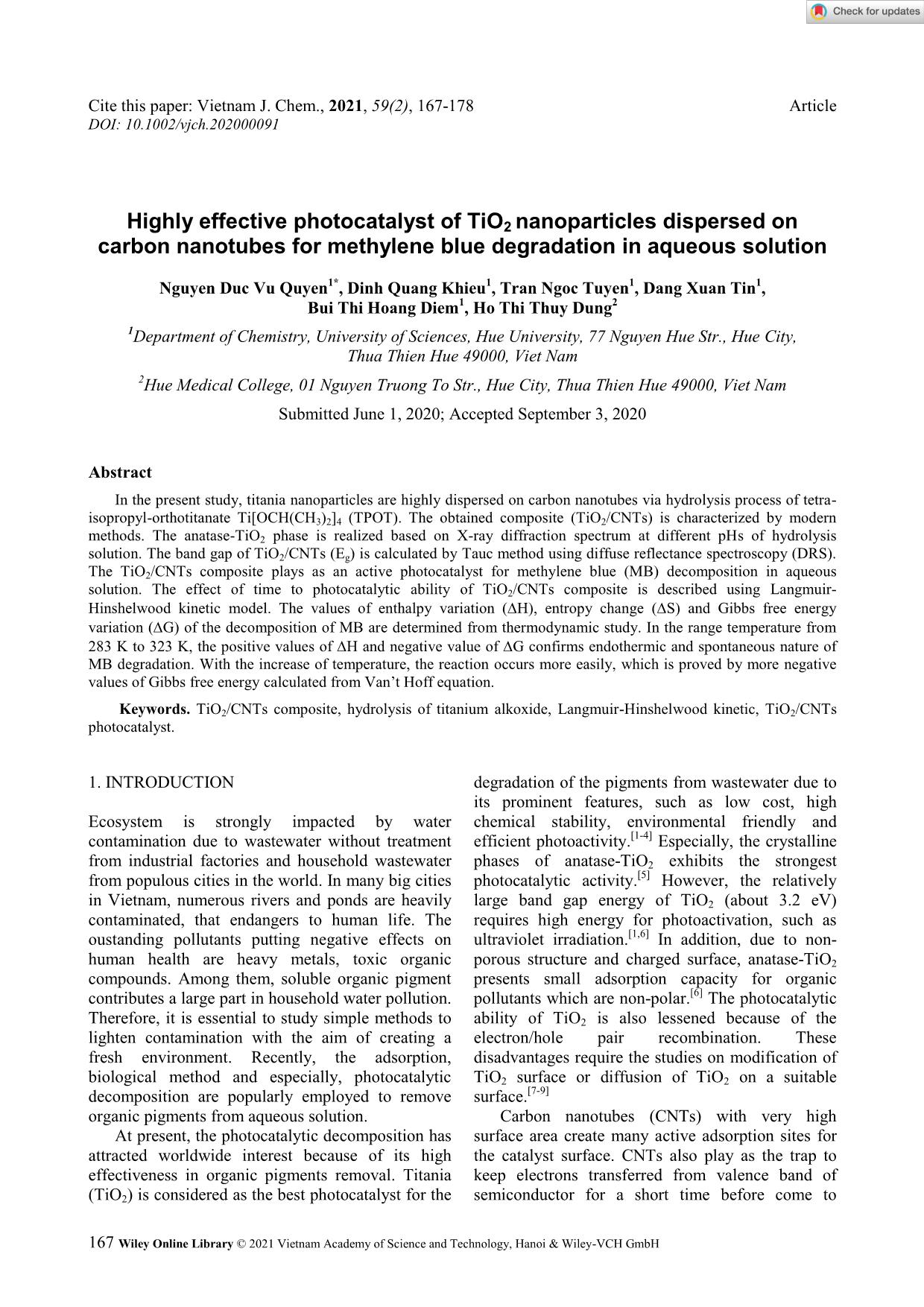
Trang 1
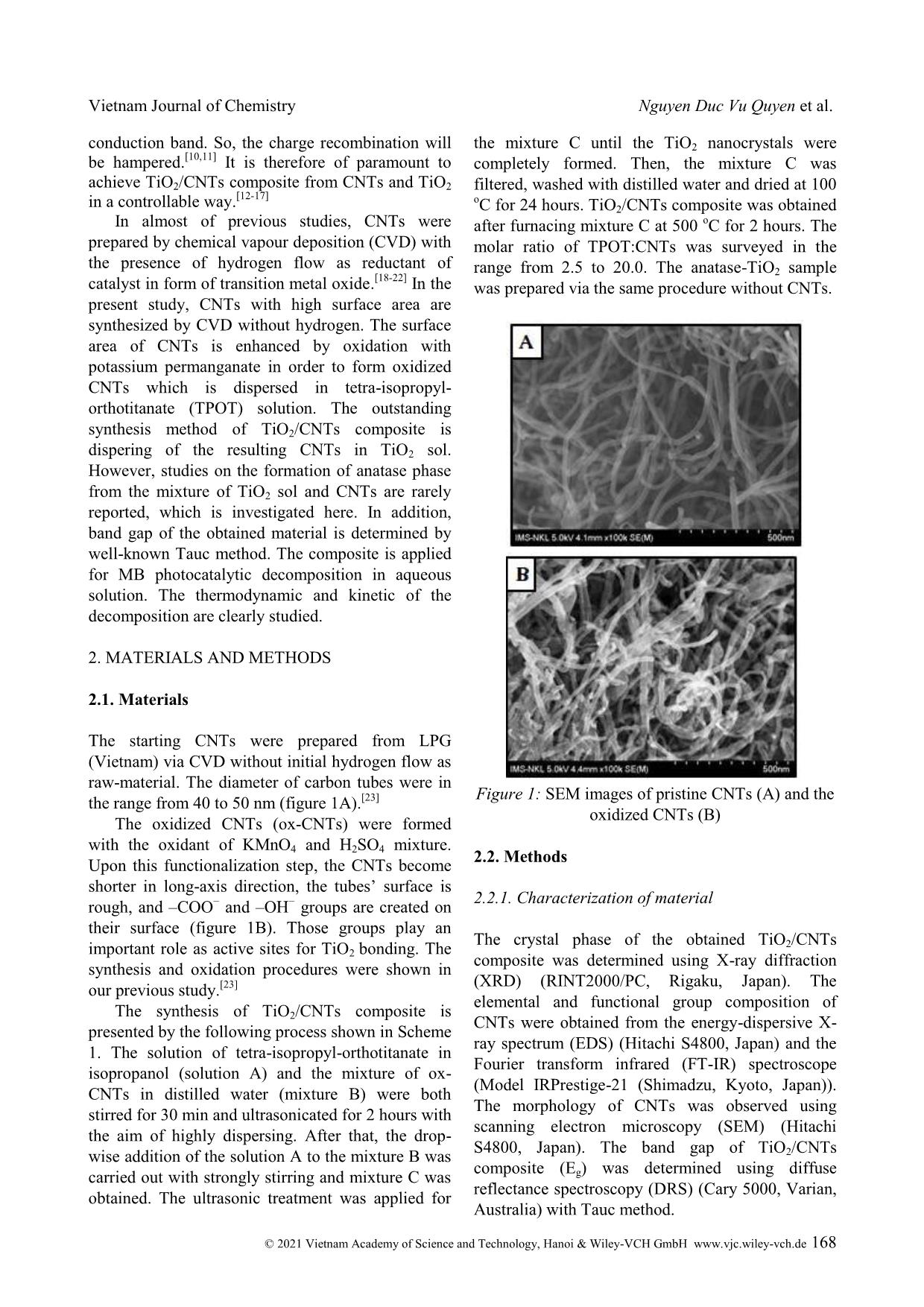
Trang 2
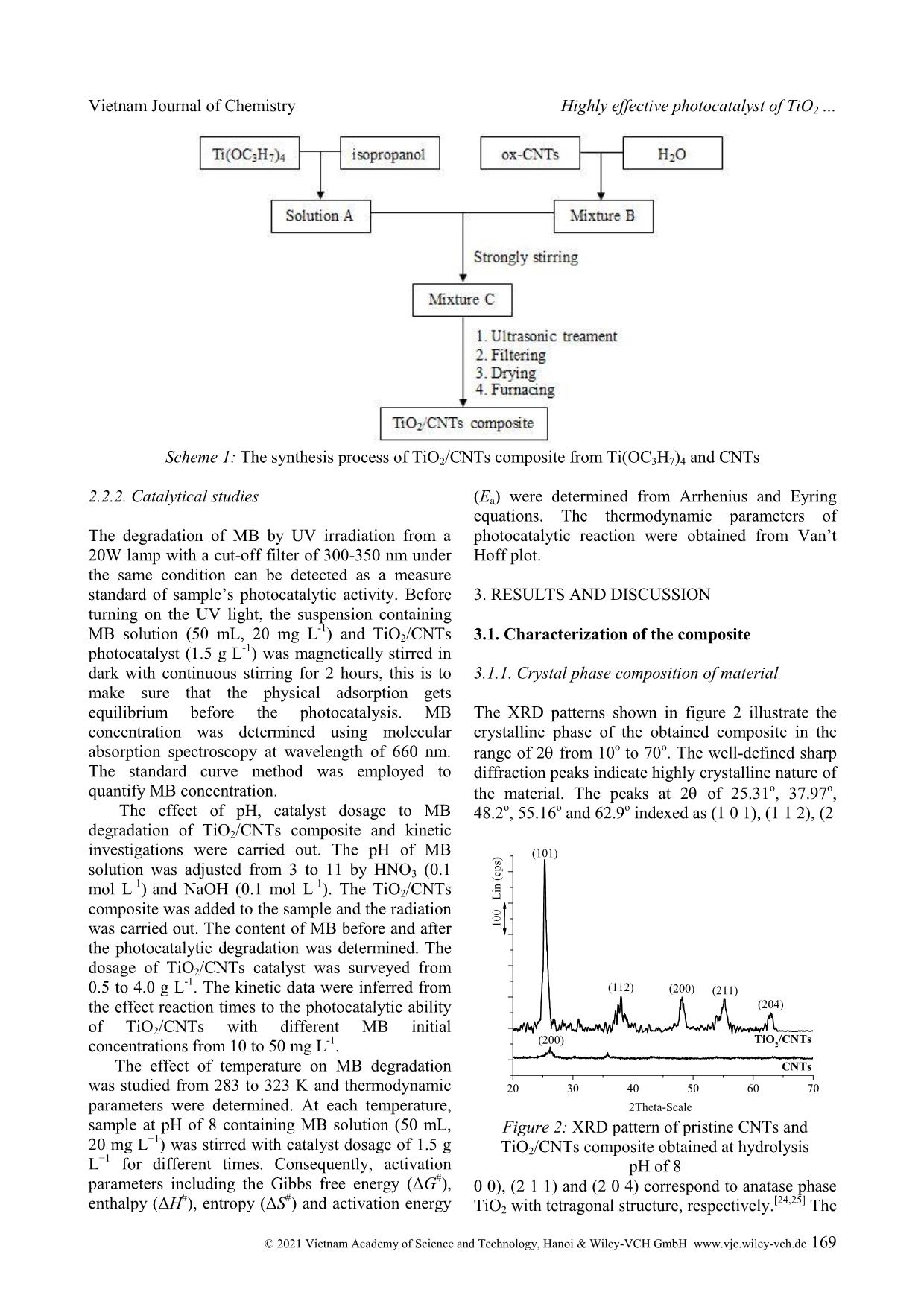
Trang 3
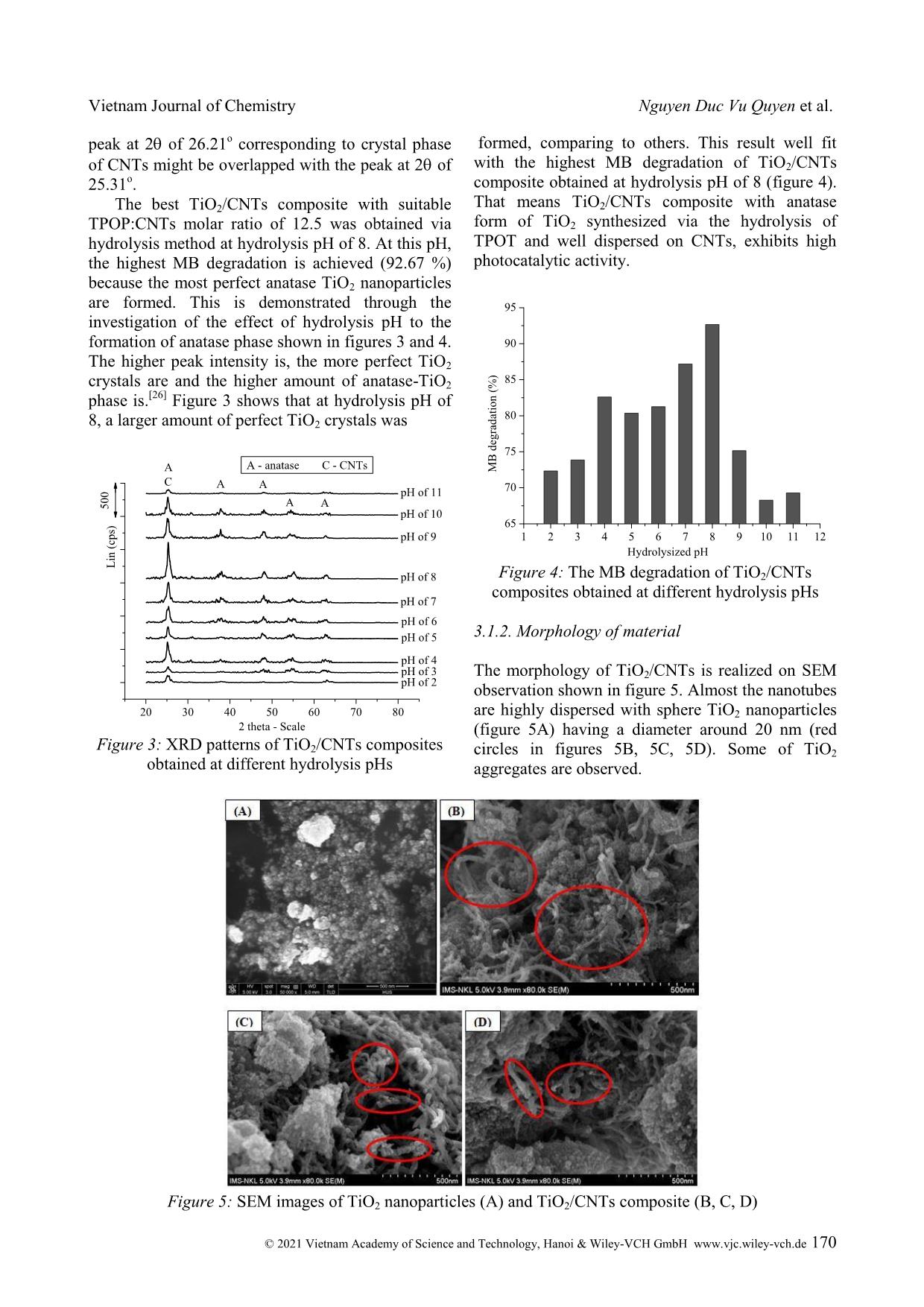
Trang 4
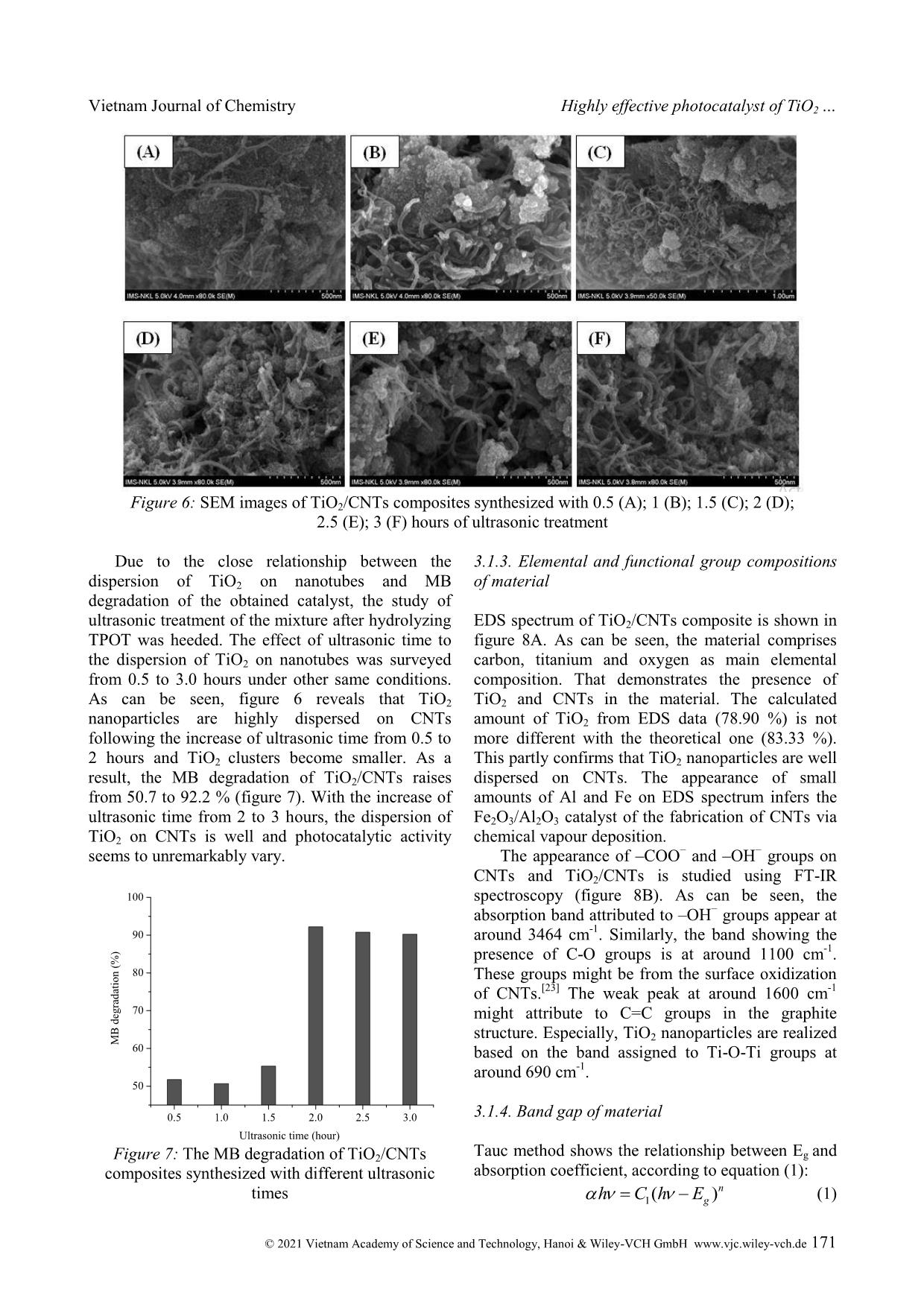
Trang 5
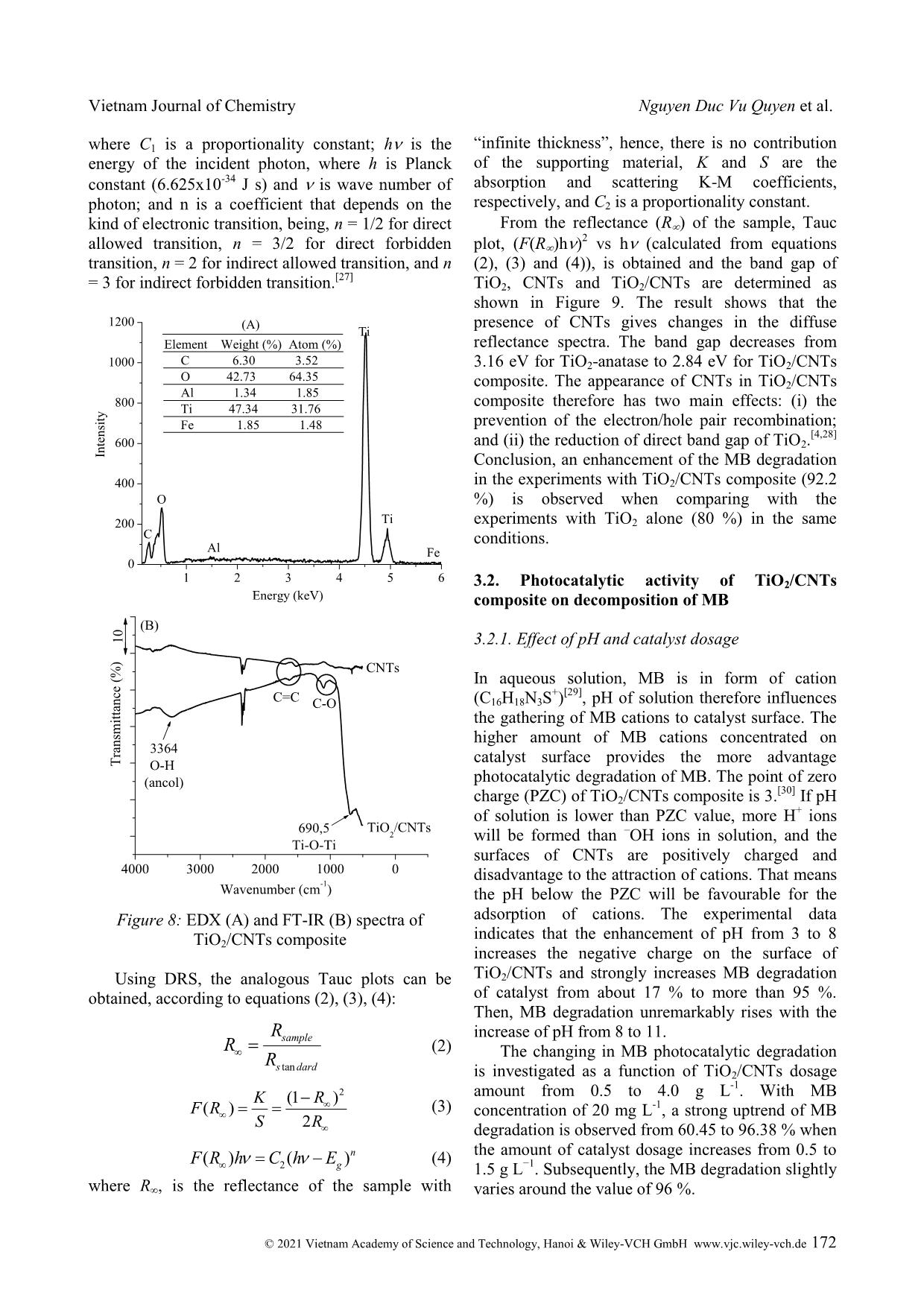
Trang 6
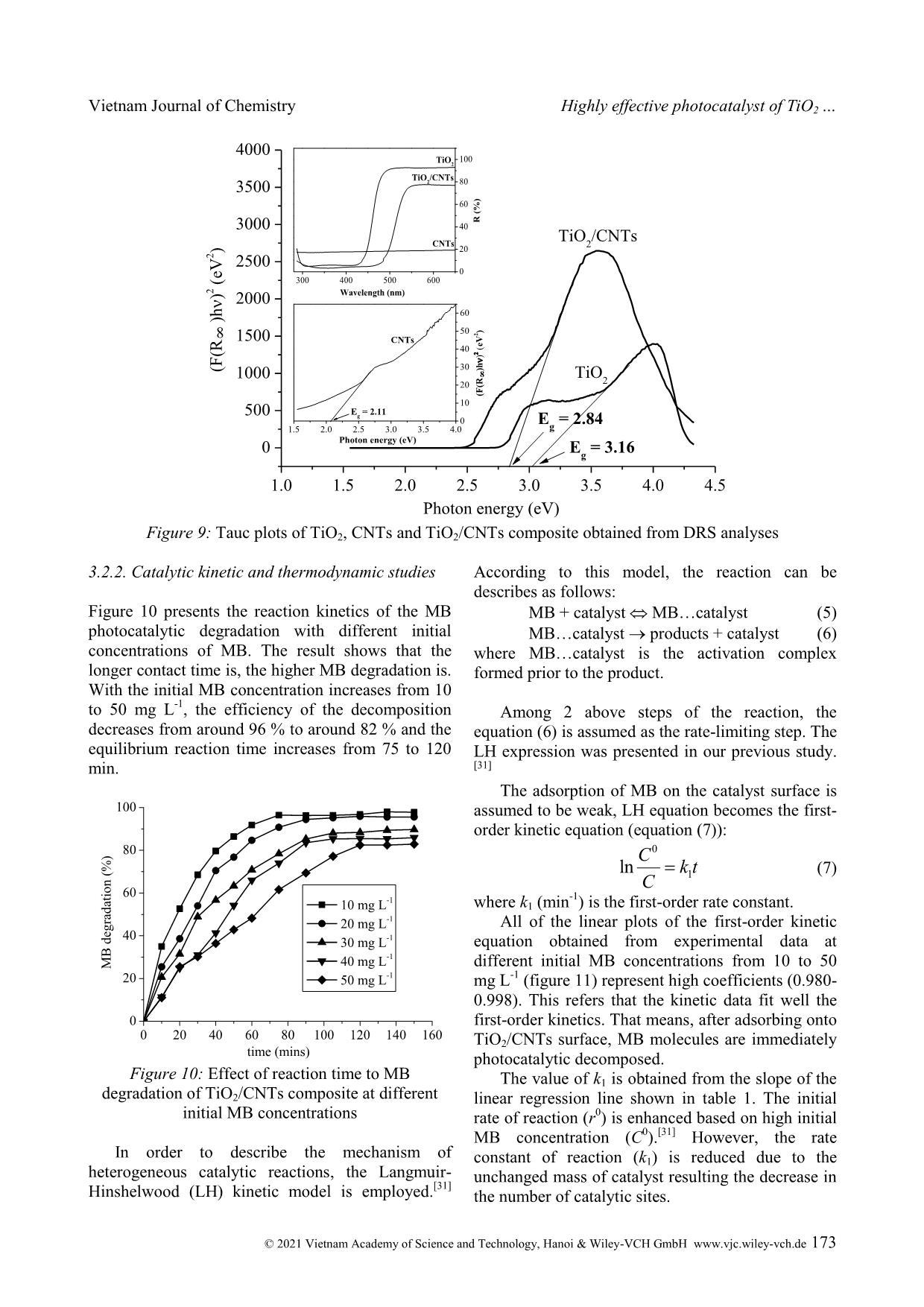
Trang 7
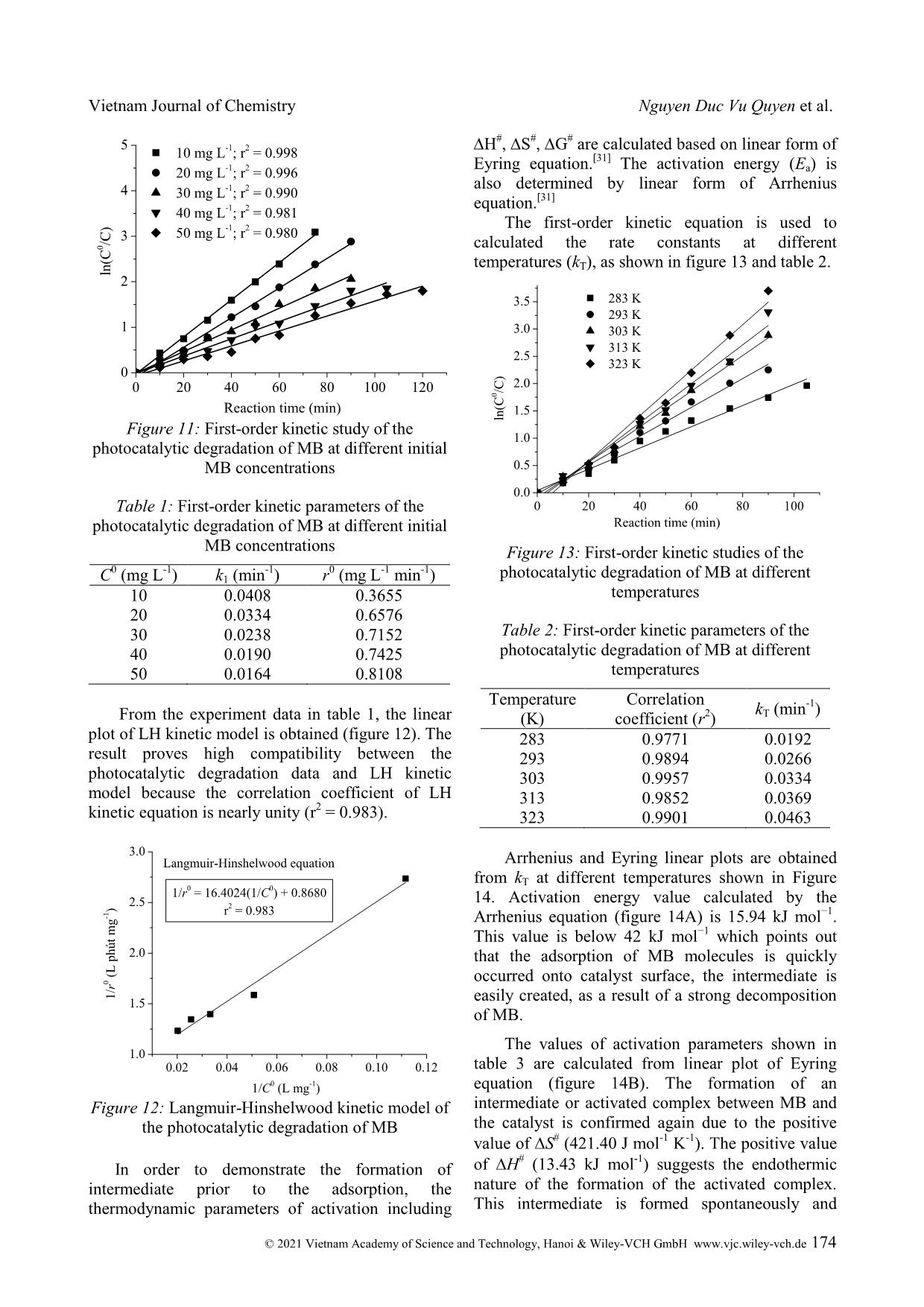
Trang 8
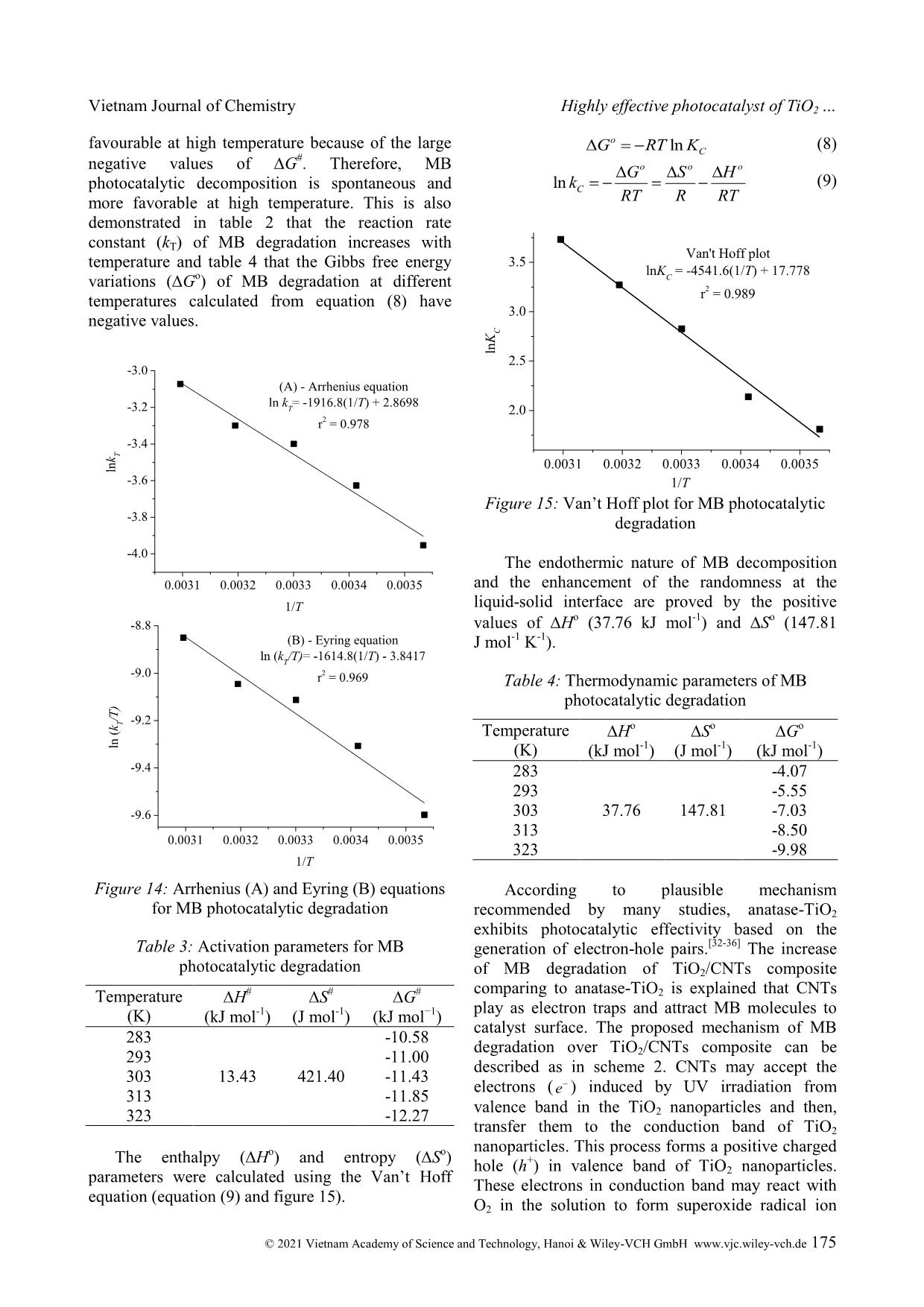
Trang 9
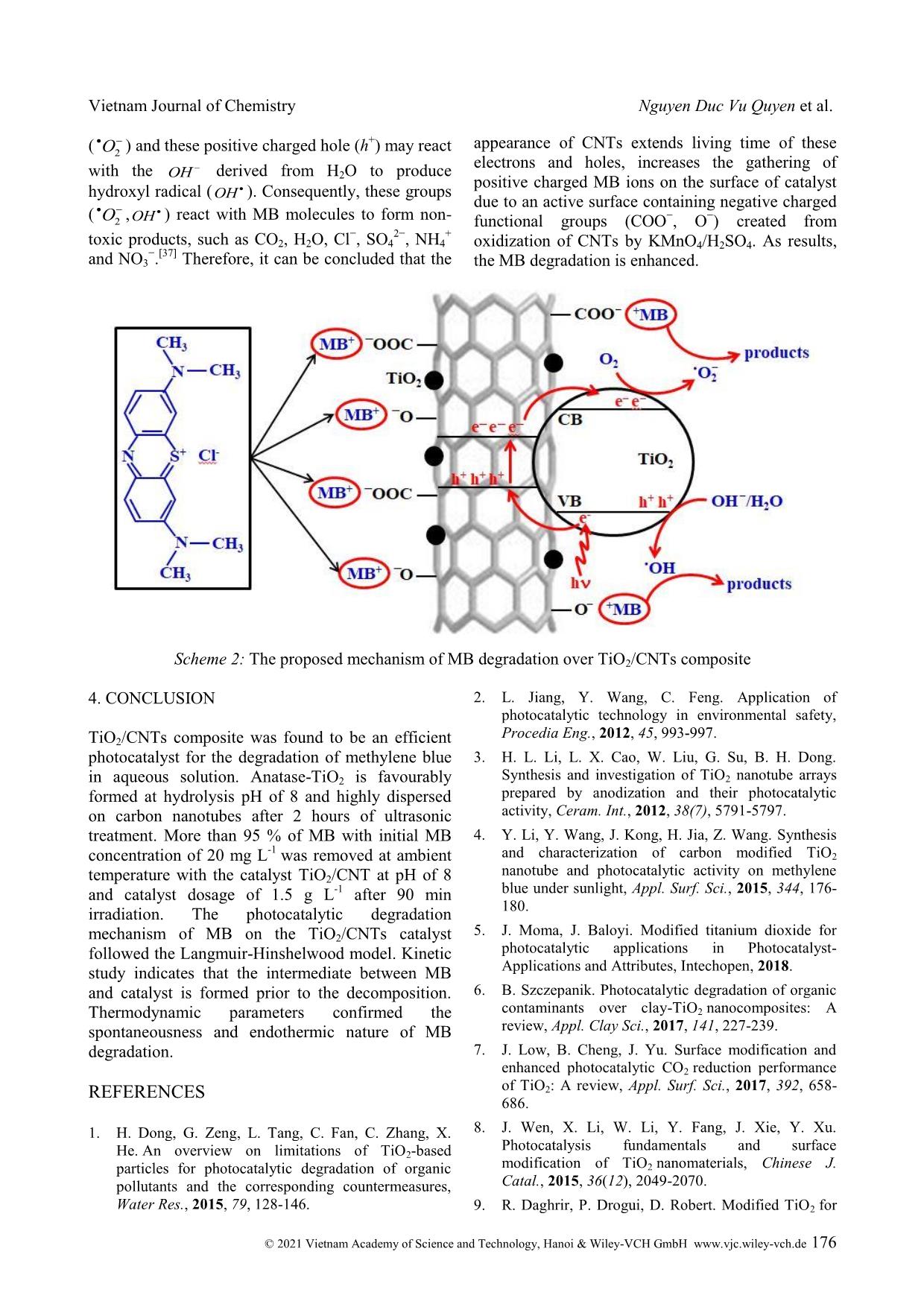
Trang 10
Tải về để xem bản đầy đủ
Tóm tắt nội dung tài liệu: Highly effective photocatalyst of TiO2 nanoparticles dispersed on carbon nanotubes for methylene blue degradation in aqueous solution
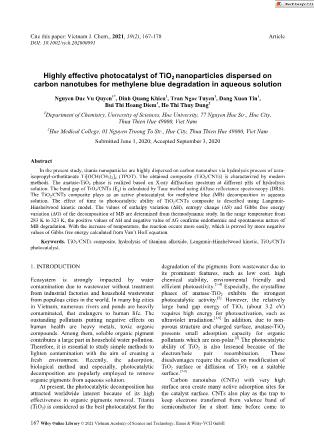
Cite this paper: Vietnam J. Chem., 2021, 59(2), 167-178 Article DOI: 10.1002/vjch.202000091 167 Wiley Online Library © 2021 Vietnam Academy of Science and Technology, Hanoi & Wiley-VCH GmbH Highly effective photocatalyst of TiO2 nanoparticles dispersed on carbon nanotubes for methylene blue degradation in aqueous solution Nguyen Duc Vu Quyen 1* , Dinh Quang Khieu 1 , Tran Ngoc Tuyen 1 , Dang Xuan Tin 1 , Bui Thi Hoang Diem 1 , Ho Thi Thuy Dung 2 1 Department of Chemistry, University of Sciences, Hue University, 77 Nguyen Hue Str., Hue City, Thua Thien Hue 49000, Viet Nam 2 Hue Medical College, 01 Nguyen Truong To Str., Hue City, Thua Thien Hue 49000, Viet Nam Submitted June 1, 2020; Accepted September 3, 2020 Abstract In the present study, titania nanoparticles are highly dispersed on carbon nanotubes via hydrolysis process of tetra- isopropyl-orthotitanate Ti[OCH(CH3)2]4 (TPOT). The obtained composite (TiO2/CNTs) is characterized by modern methods. The anatase-TiO2 phase is realized based on X-ray diffraction spectrum at different pHs of hydrolysis solution. The band gap of TiO2/CNTs (Eg) is calculated by Tauc method using diffuse reflectance spectroscopy (DRS). The TiO2/CNTs composite plays as an active photocatalyst for methylene blue (MB) decomposition in aqueous solution. The effect of time to photocatalytic ability of TiO2/CNTs composite is described using Langmuir- Hinshelwood kinetic model. The values of enthalpy variation ( H), entropy change ( S) and Gibbs free energy variation ( G) of the decomposition of MB are determined from thermodynamic study. In the range temperature from 283 K to 323 K, the positive values of H and negative value of G confirms endothermic and spontaneous nature of MB degradation. With the increase of temperature, the reaction occurs more easily, which is proved by more negative values of Gibbs free energy calculated from Van’t Hoff equation. Keywords. TiO2/CNTs composite, hydrolysis of titanium alkoxide, Langmuir-Hinshelwood kinetic, TiO2/CNTs photocatalyst. 1. INTRODUCTION Ecosystem is strongly impacted by water contamination due to wastewater without treatment from industrial factories and household wastewater from populous cities in the world. In many big cities in Vietnam, numerous rivers and ponds are heavily contaminated, that endangers to human life. The oustanding pollutants putting negative effects on human health are heavy metals, toxic organic compounds. Among them, soluble organic pigment contributes a large part in household water pollution. Therefore, it is essential to study simple methods to lighten contamination with the aim of creating a fresh environment. Recently, the adsorption, biological method and especially, photocatalytic decomposition are popularly employed to remove organic pigments from aqueous solution. At present, the photocatalytic decomposition has attracted worldwide interest because of its high effectiveness in organic pigments removal. Titania (TiO2) is considered as the best photocatalyst for the degradation of the pigments from wastewater due to its prominent features, such as low cost, high chemical stability, environmental friendly and efficient photoactivity. [1-4] Especially, the crystalline phases of anatase-TiO2 exhibits the strongest photocatalytic activity. [5] However, the relatively large band gap energy of TiO2 (about 3.2 eV) requires high energy for photoactivation, such as ultraviolet irradiation. [1,6] In addition, due to non- porous structure and charged surface, anatase-TiO2 presents small adsorption capacity for organic pollutants which are non-polar. [6] The photocatalytic ability of TiO2 is also lessened because of the electron/hole pair recombination. These disadvantages require the studies on modification of TiO2 surface or diffusion of TiO2 on a suitable surface. [7-9] Carbon nanotubes (CNTs) with very high surface area create many active adsorption sites for the catalyst surface. CNTs also play as the trap to keep electrons transferred from valence band of semiconductor for a short time before come to Vietnam Journal of Chemistry Nguyen Duc Vu Quyen et al. © 2021 Vietnam Academy of Science and Technology, Hanoi & Wiley-VCH GmbH www.vjc.wiley-vch.de 168 conduction band. So, the charge recombination will be hampered. [10,11] It is therefore of paramount to achieve TiO2/CNTs composite from CNTs and TiO2 in a controllable way. [12-17] In almost of previous studies, CNTs were prepared by chemical vapour deposition (CVD) with the presence of hydrogen flow as reductant of catalyst in form of transition metal oxide. [18-22] In the present study, CNTs with high surface area are synthesized by CVD without hydrogen. The surface area of CNTs is enhanced by oxidation with potassium permanganate in order to form oxidized CNTs which is dispersed in tetra-isopropyl- orthotitanate (TPOT) solution. The outstanding synthesis method of TiO2/CNTs composite is dispering of the resulting CNTs in TiO2 sol. However, studies on the formation of anatase phase from the mixture of TiO2 sol and CNTs are rarely reported, which is investigated here. In addition, band gap of the obtained material is determined by well-known Tauc method. The composite is applied for MB photocatalytic decomposition in aqueous solution. The thermodynamic and kinetic of the decomposition are clearly studied. 2. MATERIALS AND METHODS 2.1. Materials The starting CNTs were prepared from LPG (Vietnam) via CVD without initial hydrogen flow as raw-material. The diameter of carbon tubes were in the range from 40 to 50 nm (figure 1A). [23] The oxidized CNTs (ox-CNTs) were formed with the oxidant of KMnO4 and H2SO4 mixture. Upon this functionalization step, the CNTs become shorter in long-axis direction, the tubes’ surface is ... 2: First-order kinetic parameters of the photocatalytic degradation of MB at different temperatures Temperature (K) Correlation coefficient (r 2 ) kT (min -1 ) 283 0.9771 0.0192 293 0.9894 0.0266 303 0.9957 0.0334 313 0.9852 0.0369 323 0.9901 0.0463 Arrhenius and Eyring linear plots are obtained from kT at different temperatures shown in Figure 14. Activation energy value calculated by the Arrhenius equation (figure 14A) is 15.94 kJ mol −1 . This value is below 42 kJ mol −1 which points out that the adsorption of MB molecules is quickly occurred onto catalyst surface, the intermediate is easily created, as a result of a strong decomposition of MB. The values of activation parameters shown in table 3 are calculated from linear plot of Eyring equation (figure 14B). The formation of an intermediate or activated complex between MB and the catalyst is confirmed again due to the positive value of S# (421.40 J mol-1 K-1). The positive value of H# (13.43 kJ mol-1) suggests the endothermic nature of the formation of the activated complex. This intermediate is formed spontaneously and Vietnam Journal of Chemistry Highly effective photocatalyst of TiO2 © 2021 Vietnam Academy of Science and Technology, Hanoi & Wiley-VCH GmbH www.vjc.wiley-vch.de 175 favourable at high temperature because of the large negative values of G#. Therefore, MB photocatalytic decomposition is spontaneous and more favorable at high temperature. This is also demonstrated in table 2 that the reaction rate constant (kT) of MB degradation increases with temperature and table 4 that the Gibbs free energy variations (∆Go) of MB degradation at different temperatures calculated from equation (8) have negative values. 0.0031 0.0032 0.0033 0.0034 0.0035 -4.0 -3.8 -3.6 -3.4 -3.2 -3.0 ln k T 1/T (A) - Arrhenius equation ln k T = -1916.8(1/T) + 2.8698 r 2 = 0.978 0.0031 0.0032 0.0033 0.0034 0.0035 -9.6 -9.4 -9.2 -9.0 -8.8 1/T (B) - Eyring equation ln (k T /T)= -1614.8(1/T) - 3.8417 r 2 = 0.969 ln ( k T /T ) Figure 14: Arrhenius (A) and Eyring (B) equations for MB photocatalytic degradation Table 3: Activation parameters for MB photocatalytic degradation Temperature (K) H# (kJ mol -1 ) S# (J mol -1 ) G# (kJ mol −1 ) 283 13.43 421.40 -10.58 293 -11.00 303 -11.43 313 -11.85 323 -12.27 The enthalpy ( Ho) and entropy ( So) parameters were calculated using the Van’t Hoff equation (equation (9) and figure 15). lno CG RT K (8) ln o o o C G S H k RT R RT (9) 0.0031 0.0032 0.0033 0.0034 0.0035 2.0 2.5 3.0 3.5 1/T ln K C Van't Hoff plot lnK C = -4541.6(1/T) + 17.778 r 2 = 0.989 Figure 15: Van’t Hoff plot for MB photocatalytic degradation The endothermic nature of MB decomposition and the enhancement of the randomness at the liquid-solid interface are proved by the positive values of Ho (37.76 kJ mol-1) and So (147.81 J mol -1 K -1 ). Table 4: Thermodynamic parameters of MB photocatalytic degradation Temperature (K) Ho (kJ mol -1 ) So (J mol -1 ) Go (kJ mol -1 ) 283 37.76 147.81 -4.07 293 -5.55 303 -7.03 313 -8.50 323 -9.98 According to plausible mechanism recommended by many studies, anatase-TiO2 exhibits photocatalytic effectivity based on the generation of electron-hole pairs. [32-36] The increase of MB degradation of TiO2/CNTs composite comparing to anatase-TiO2 is explained that CNTs play as electron traps and attract MB molecules to catalyst surface. The proposed mechanism of MB degradation over TiO2/CNTs composite can be described as in scheme 2. CNTs may accept the electrons (e ) induced by UV irradiation from valence band in the TiO2 nanoparticles and then, transfer them to the conduction band of TiO2 nanoparticles. This process forms a positive charged hole (h + ) in valence band of TiO2 nanoparticles. These electrons in conduction band may react with O2 in the solution to form superoxide radical ion Vietnam Journal of Chemistry Nguyen Duc Vu Quyen et al. © 2021 Vietnam Academy of Science and Technology, Hanoi & Wiley-VCH GmbH www.vjc.wiley-vch.de 176 ( 2O ) and these positive charged hole (h + ) may react with the OH derived from H2O to produce hydroxyl radical (OH ). Consequently, these groups ( 2O ,OH ) react with MB molecules to form non- toxic products, such as CO2, H2O, Cl − , SO4 2− , NH4 + and NO3 − . [37] Therefore, it can be concluded that the appearance of CNTs extends living time of these electrons and holes, increases the gathering of positive charged MB ions on the surface of catalyst due to an active surface containing negative charged functional groups (COO − , O − ) created from oxidization of CNTs by KMnO4/H2SO4. As results, the MB degradation is enhanced. Scheme 2: The proposed mechanism of MB degradation over TiO2/CNTs composite 4. CONCLUSION TiO2/CNTs composite was found to be an efficient photocatalyst for the degradation of methylene blue in aqueous solution. Anatase-TiO2 is favourably formed at hydrolysis pH of 8 and highly dispersed on carbon nanotubes after 2 hours of ultrasonic treatment. More than 95 % of MB with initial MB concentration of 20 mg L -1 was removed at ambient temperature with the catalyst TiO2/CNT at pH of 8 and catalyst dosage of 1.5 g L -1 after 90 min irradiation. The photocatalytic degradation mechanism of MB on the TiO2/CNTs catalyst followed the Langmuir-Hinshelwood model. Kinetic study indicates that the intermediate between MB and catalyst is formed prior to the decomposition. Thermodynamic parameters confirmed the spontaneousness and endothermic nature of MB degradation. REFERENCES 1. H. Dong, G. Zeng, L. Tang, C. Fan, C. Zhang, X. He. An overview on limitations of TiO2-based particles for photocatalytic degradation of organic pollutants and the corresponding countermeasures, Water Res., 2015, 79, 128-146. 2. L. Jiang, Y. Wang, C. Feng. Application of photocatalytic technology in environmental safety, Procedia Eng., 2012, 45, 993-997. 3. H. L. Li, L. X. Cao, W. Liu, G. Su, B. H. Dong. Synthesis and investigation of TiO2 nanotube arrays prepared by anodization and their photocatalytic activity, Ceram. Int., 2012, 38(7), 5791-5797. 4. Y. Li, Y. Wang, J. Kong, H. Jia, Z. Wang. Synthesis and characterization of carbon modified TiO2 nanotube and photocatalytic activity on methylene blue under sunlight, Appl. Surf. Sci., 2015, 344, 176- 180. 5. J. Moma, J. Baloyi. Modified titanium dioxide for photocatalytic applications in Photocatalyst- Applications and Attributes, Intechopen, 2018. 6. B. Szczepanik. Photocatalytic degradation of organic contaminants over clay-TiO2 nanocomposites: A review, Appl. Clay Sci., 2017, 141, 227-239. 7. J. Low, B. Cheng, J. Yu. Surface modification and enhanced photocatalytic CO2 reduction performance of TiO2: A review, Appl. Surf. Sci., 2017, 392, 658- 686. 8. J. Wen, X. Li, W. Li, Y. Fang, J. Xie, Y. Xu. Photocatalysis fundamentals and surface modification of TiO2 nanomaterials, Chinese J. Catal., 2015, 36(12), 2049-2070. 9. R. Daghrir, P. Drogui, D. Robert. Modified TiO2 for Vietnam Journal of Chemistry Highly effective photocatalyst of TiO2 © 2021 Vietnam Academy of Science and Technology, Hanoi & Wiley-VCH GmbH www.vjc.wiley-vch.de 177 environmental photocatalytic applications: A review, Ind. Eng. Chem. Res., 2013, 52(10), 3581-3599. 10. K. Woan, G. Pyrgiotakis, W. Sigmund. Photocatalytic carbonnanotube-TiO2 composites, Adv. Mater., 2009, 21, 2233-2239. 11. R. Leary, A. Westwood. Carbonaceous nanomaterials for the enhancement of TiO2 photocatalysis, Carbon, 2011, 49, 741-772. 12. W. Wang, P. Serp, P. Kalck and J. L. Faria. Visible Light Photodegradation of Phenol on MWNT- TiO2 Composite Catalysts Prepared by a Modified Sol-Gel Method, J. Mol. Catal. A: Chem., 2005, 235(1-2), 194-199. 13. W. Phang, M. Tadokoro, J. Watanabe and N. Kuramoto. Synthesis, characterization and microwave absorption property of doped polyaniline nanocomposites containing TiO2 nanoparticles and carbon nanotubes, Synth. Met., 2008, 158(6), 251- 258. 14. A. Jitianu, T. Cacciaguerra, R. Benoit, S. Delpeux, F. Beguin, S. Bonnamy. Synthesis and characterization of carbon nanotubes-TiO2 Nanocomposites, Carbon, 2004, 42, 1147-1151. 15. X-B. Yan, B. K. Tay, and Y. Yang. Dispersing and Functionalizing Multiwalled Carbon Nanotubes in TiO2 Sol, J. Phys. Chem. A, 2006, 110, 25844-25849. 16. L. Tian, L. Ye, K. Deng, L. Zan. TiO2/carbon nanotube hybrid nanostructures: Solvothermal synthesis and their visible light photocatalytic activity, J. Solid State Chem., 2011, 184, 1465-1471. 17. V. R. Djokic, A. D. Marinkovic, M. Mitric, P. S. Uskokovic, R. D. Petrovic, V. R. Radmilovic, D. T. Janackovic. Preparation of TiO2/carbon nanotubes photocatalysts: The influence of the method of oxidation of the carbonnanotubes on the photocatalytic activity of the nanocomposites, Ceram. Int., 2012, 38, 6123-6129. 18. B. Kitiyanan, W. E. Alvarez, J. H. Harwell, D. E. Resasco. Controlled production of single-wall carbon nanotubes by catalytic decomposition of CO on bimetallic Co–Mo catalysts, Chem. Phys. Lett., 2000, 317, 497-503. 19. C. L. Cheung, A. Kurtz, H. Park and C. M. Lieber. Diameter-Controlled Synthesis of Carbon Nanotubes, J. Phys. Chem. B, 2002, 106(10), 2429-2433. 20. U. C. Chung. Effect of H2 on formation behavior of carbon nanotubes, Bull. Korean Chem. Soc., 2004, 25(10), 1521-1524. 21. A. Firouzi, S. Sobri, F. M. Yasin, F. L. R. Ahmadun. Synthesis of carbon nanotubes by chemical vapor deposition and their application for CO2 and CH4 detection, Int. Proc. Chem., Bio. Environ. Eng., 2011, 2, 169-172. 22. Y. S. Shin, J. Y. Hong, D. H. Ryu, M. H. Yum, J. H. Yang and C-Y. Park. The Role of H2 in the Growth of Carbon Nanotubes on an AAO Template, J. Korean Phys. Soc., 2007, 50(4), 1068-1072. 23. D. V. Q. Nguyen, Q. K. Dinh, N. T. Tran, X. T. Dang, and T. H. D. Bui. Carbon Nanotubes: Synthesis via Chemical Vapour Deposition without Hydrogen, Surface Modification, and Application, J. Chem., 2019, 2019. 24. P. Srinivasu, S. P. Singh, A. Islam, and L. Han. Novel Approach for the Synthesis of Nanocrystalline Anatase Titania and Their Photovoltaic Application, Adv. Optoelectron., 2011, 2011. 25. H. Ijadpanah-Saravy, M. Safari, A. Khodadadi- Darban & A. Rezaei. Synthesis of Titanium Dioxide Nanoparticles for Photocatalytic Degradation of Cyanide in Wastewater, Anal. Lett., 2014, 47, 1772- 1782. 26. Z. Jian & W. Hejing. The physical meanings of 5 basic parameters for an X-ray diffraction peak and their application, Chin. J. Geochem., 2003, 22(1), 38- 44. 27. A. Escobedo-Morales, I. I. Ruiz-López, M.deL. Ruiz- Peralta, L. Tepech-Carrillo, M. Sánchez-Cantú, J. E. Moreno-Orea. Automated method for the determination of the band gap energy of pure and mixed powder samples using diffuse reflectance spectroscopy, Heliyon, 2019, 5(4), e01505. 28. M. Barberio, P. Barone, A. Imbrogno, S. A. Ruffolo, M. L. Russa, N. Arcuri and F. Xu. Study of Band Gap of Carbon Nanotube-Titanium Dioxide Heterostructures, J. Chem. Chem. Eng., 2014, 8, 36- 41. 29. M. M. Ayad, and A. B. El-Nasr. Adsorption of cationic dye (Methylene blue) from water using polyaniline nanotubes base, J. Phys. Chem. C, 2010, 114, 14377-14383. 30. D. V. Bavykin, E. V. Milsom, F. Marken, D. H. Kim, D. H. Marsh, D. J. Riley, F. C. Walsh, K. H. El- Abiary, A. A. Lapkin. A novel cation-binding TiO2 nanotube substrate for elctro- and bioelectro- catalysis, Electrochem. Commun., 2005, 7, 1050- 1058. 31. D. V. Q. Nguyen, N. T. Tran, Q. K. Dinh, V. M. H. Ho, X. T. Dang, and K. Itatani. Oxidation of dibenzothiophene using the heterogeneous catalyst of tungsten-based carbon nanotubes, Green Process. Synth., 2019, 2019. 32. C. Yang, W. Dong, G. Cui, Y. Zhao, X. Shi, X. Xia, B. Tang and W. Wang. Highly efficient photocatalytic degradation of methylene blue by P2ABSA-modified TiO2 nanocomposite due to the photosensitization synergetic effect of TiO2 and P2ABSA, RSC Adv., 2017, 7(38), 23699-23708. 33. S. Bougarrani, K. Skadell, R. Arndt, M. Azzouzi, R. Gläser. Novel CaxMnOy/TiO2 composites for efficient photocatalytic degradation of methylene blue and the herbicide imazapyr in aqueous solution Vietnam Journal of Chemistry Nguyen Duc Vu Quyen et al. © 2021 Vietnam Academy of Science and Technology, Hanoi & Wiley-VCH GmbH www.vjc.wiley-vch.de 178 under visible light irradiation, J. Environ. Chem. Eng., 2018, 6(2), 1934-1942. 34. F. Bairamis, I. Konstantinou, D. Petrakis, T. Vaimakis. Enhanced performance of electrospun nanofibrous TiO2/g-C3N4 photocatalyst in photocatalytic degradation of methylene blue, Catalysts, 2019, 9(11), 880-893. 35. R. Kumar, J. Rashid, M. A. Barakat. Zero valent Ag deposited TiO2 for the efficient photocatalysis of methylene blue under UV-C light irradiation, Colloids Interface Sci. Commun., 2015, 5, 1-4. 36. W-C. Oh and M-L. Chen. Synthesis and Characterization of CNT/TiO2 Composites Thermally Derived from MWCNT and Titanium(IV) n- Butoxide, Bull. Korean Chem. Soc., 2008, 29(1), 159-166. 37. A. Houas, H. Lachheb, M. Ksibi, E. Elaloui, C. Guillard, J-M. Herrmann. Photocatalytic degradation pathway of methylene blue in water, Appl. Catal. B: Environ., 2001, 31(2), 145-157. Corresponding author: Nguyen Duc Vu Quyen University of Sciences - Hue University 77, Nguyen Hue Str., Hue City, Thua Thien Hue 49000, Viet Nam E-mail: ndvquyen@hueuni.edu.vn Tel: +84- 979590971.
File đính kèm:
 highly_effective_photocatalyst_of_tio2_nanoparticles_dispers.pdf
highly_effective_photocatalyst_of_tio2_nanoparticles_dispers.pdf

